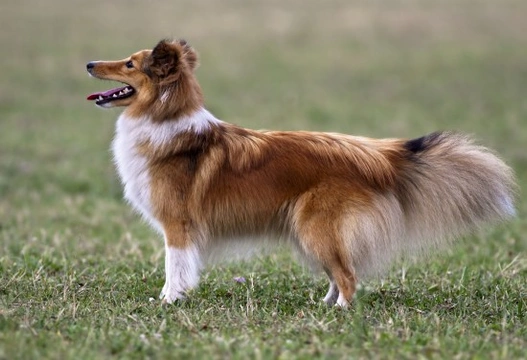
Shetland sheepdog hereditary health and health testing
The Shetland sheepdog is also sometimes referred to as the “Sheltie,” and is a small to medium sized dog that is classed as a working herding breed. They are lively, energetic dogs that are prone to being excitable, which, when channelled properly, makes them excellent working dogs for farmers but can make them a handful as well! The breed was originally developed from working dogs in the Shetland Isles, and it is thought that their ancestry also includes the Scottish collie and the King Charles spaniel. The Shetland sheepdog is a good choice for work on the Shetland isles due to the small size of the dog, which is in line with the small breeds of sheep that are also resident on the islands.
The Shetland sheepdog can stand up to 16” tall at the withers, and weigh up to 10.9kg, and males and females tend to be around the same size.
The Shetland sheepdog has a long, thick double coat, which can be found in a wide range of colours including sable of various shades, tricolour, bi-black, bi-blue, blue merle, bi-blue merle, sable merle, double merle, and colour headed white. Their coats require a significant amount of brushing and grooming to keep them in good condition, and without this, their coats soon become knotted and tangled.
If you are wondering if the Shetland sheepdog is the right choice of dog for you, it is important to find out as much as possible about the breed, including their health and longevity. We will look at these factors in more detail within this article.
Shetland sheepdog longevity
The average lifespan of the Shetland sheepdog is 12-13 years, which places the breed in the average figure across the board for all breeds of a similar size and build.
Genetic diversity
The coefficient of inbreeding statistic for the Shetland sheepdog is 6.7%, which is just a touch higher than the accepted ideal of 6.25% or lower that is advised for pedigree dog breeds. While the average for the Shetland sheepdog is only a little higher than the ideal, breeders should seek to reduce the coefficient of inbreeding statistic within their own breed lines where possible.
Conformation
The general shape and build of the Shetland sheepdog is considered to be well balanced and proportionate, and is well suited to the dog’s original working roles. However, their coat is thick and profuse, designed to provide protection in the often cold islands of the north of Scotland, and as such, may lead to overheating in hot weather. Care must be taken to ensure that the dog can keep cool enough in the summer, and their coats require a significant amount of brushing and grooming as well.
Health testing for the Shetland sheepdog
The Kennel Club and the British Veterinary Association collate statistics for hereditary health problems across pedigree breeds, and make recommendations for pre-breeding health screening to help to increase the health of the breed as a whole. The following health tests are advised for the Shetland sheepdog:
- Hip score testing, with the breed’s mean hip score being 12.7. Potential parent dogs of the breed should receive a hip score below this figure to be considered viable for breeding.
- Eye testing for conditions including Collie eye anomaly, retinal pigment epithelial dystrophy, progressive retinal atrophy, and central progressive retinal atrophy.
DNA tests are also available for certain conditions:
- Collie eye anomaly.
- MDR1, or multi-drug resistance.
- Von Willebrand’s factor.
- Merle gene testing.
- Degenerative myelopathy of the spinal cord.
Other health issues
The Shetland sheepdog is generally thought of as a robust and hardy little dog, and not one that is particularly fragile or prone to developing minor ills. However, there are quite a few hereditary health problems within the breed, as can be seen above, as well as a reasonable range of other conditions for which pre-breeding health screening is not available.
Potential Shetland sheepdog owners should be aware of the following conditions:
- Patent ductus arteriosus, a heart condition that leads to heart murmur with varying degrees of severity.
- Distichiasis, a condition in which the eyelashes grow an additional row, which rub against the eyeballs.
- Haemophilia B.
- Hypothyroidism, or an underactive thyroid gland.
- Basal cell tumours.
- Urinary bladder tumours.
- Nasal carcinomas.
- Corneal dystrophy of the eyes.
- Hereditary deafness.
- An autoimmune disease called pemphigus foliaceus, in which skin lesions develop.
- Cutaneous lupus erythematous, another autoimmune condition that leads to skin lesions.
- Gall bladder disease.
- Sensitivity to Ivermectin, Milbemycin, and other drugs.
- Microblepharon, a condition in which the dog’s eyelids are too small, leading to eye problems.
- Dermatomyositis, an inflammatory condition of the skin that leads to hair loss and skin lesions, and can also affect the throat and musculature.
- Uveodermatological syndrome, an autoimmune condition that leads to tissue destruction, which ultimately leads to blindness and death.



